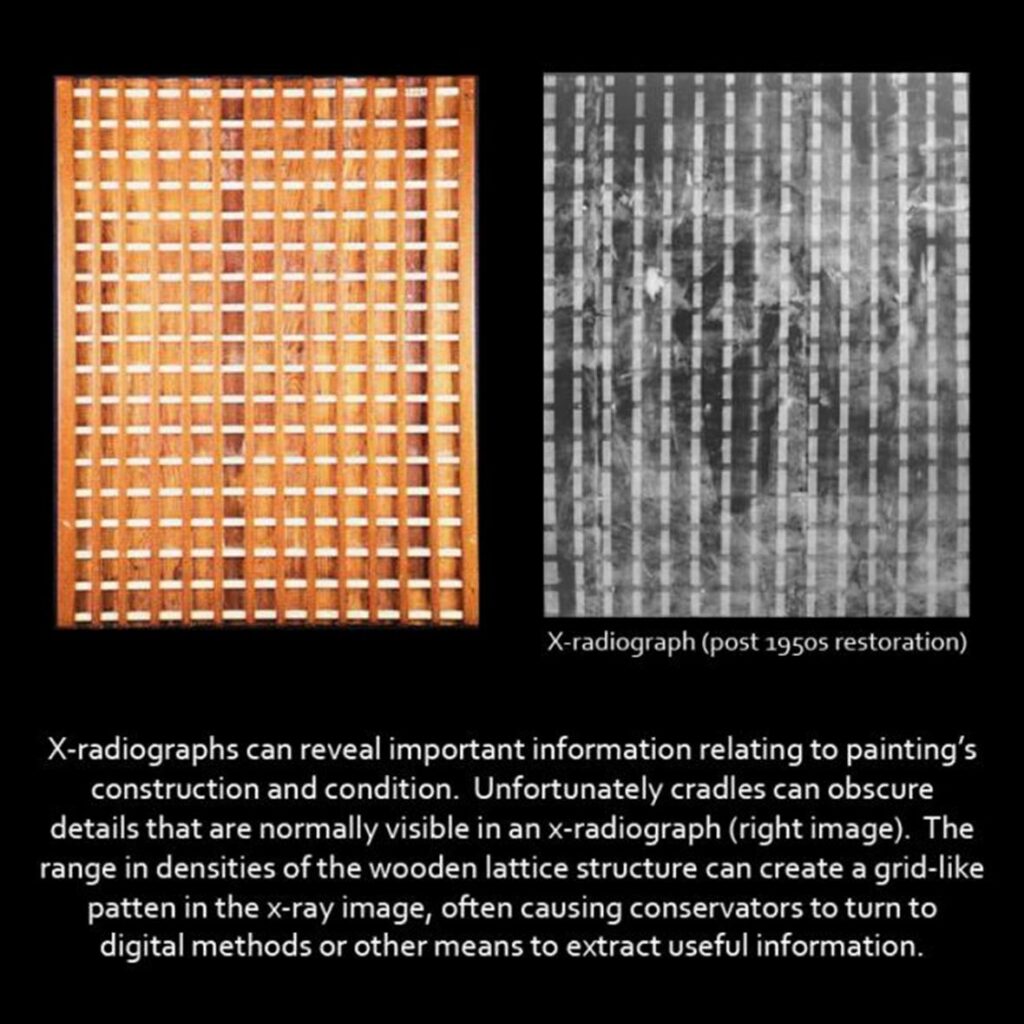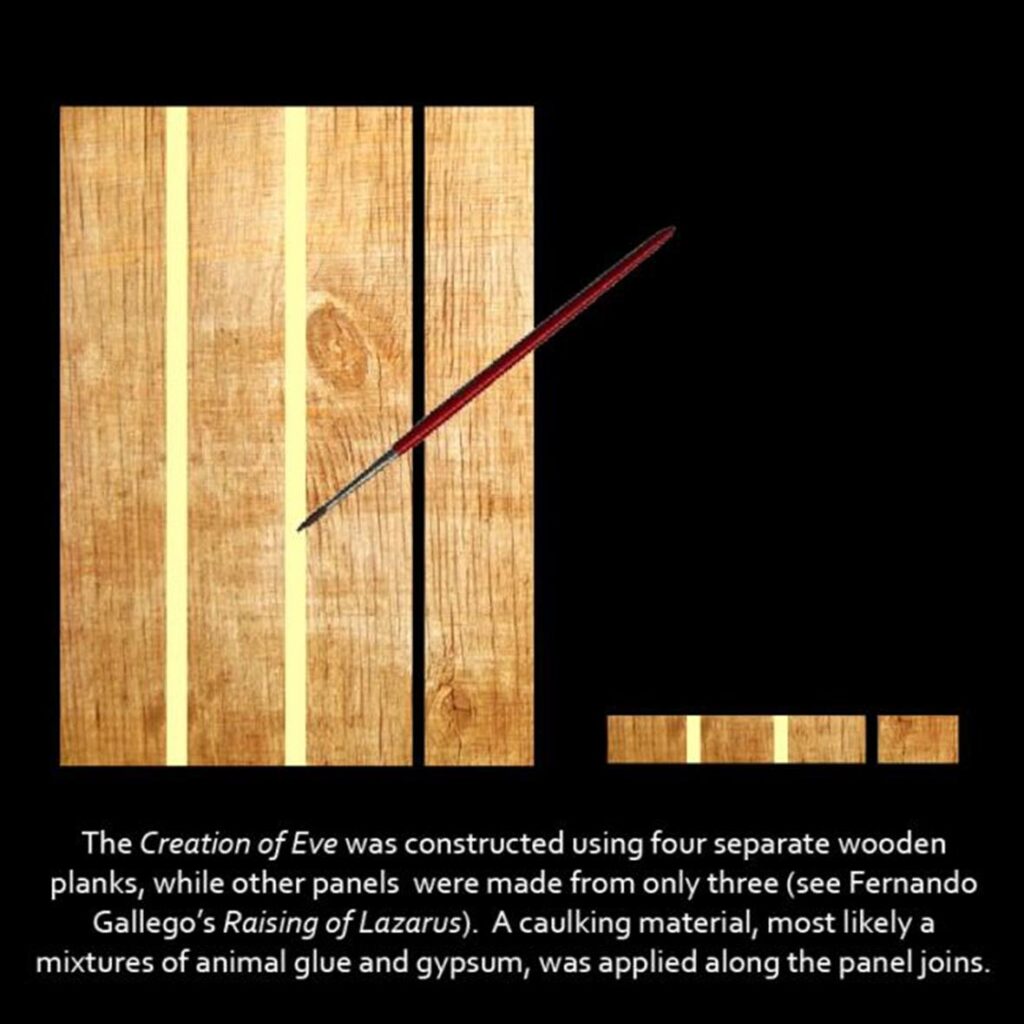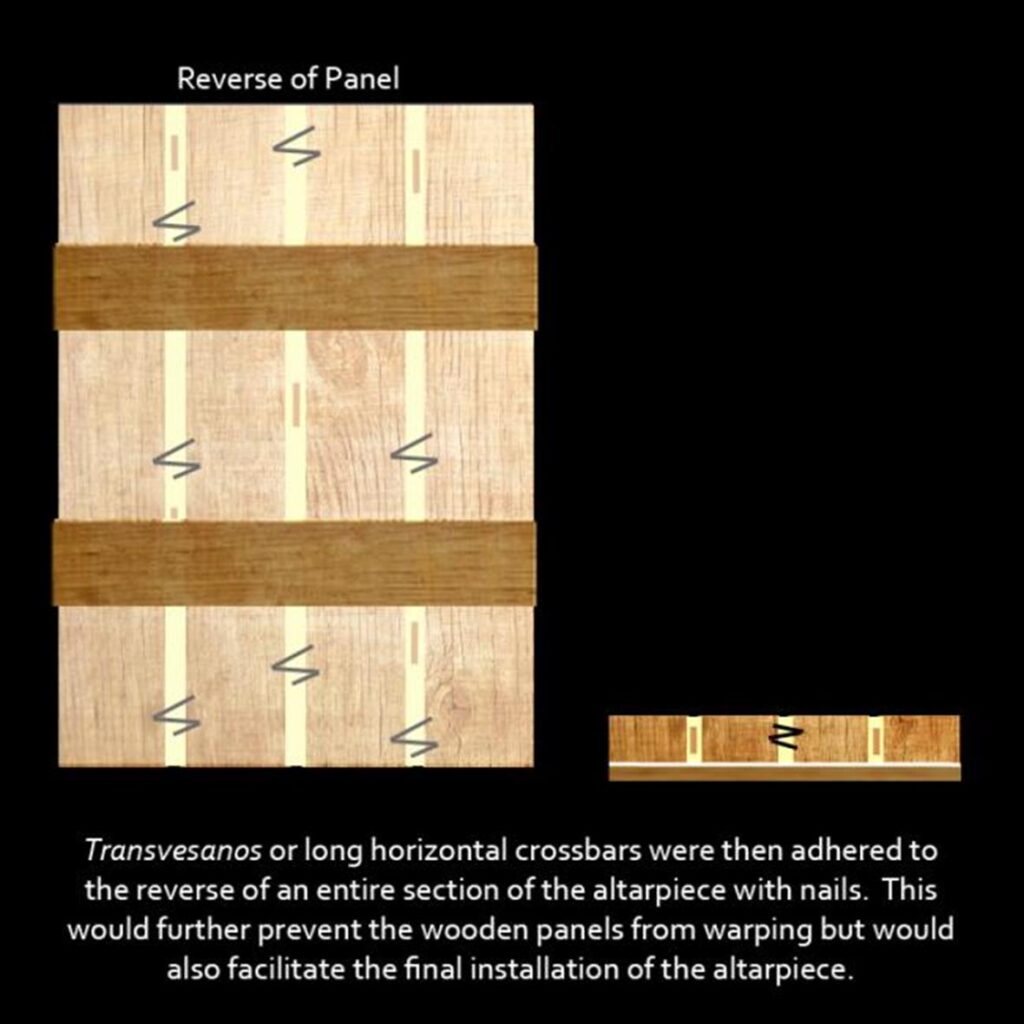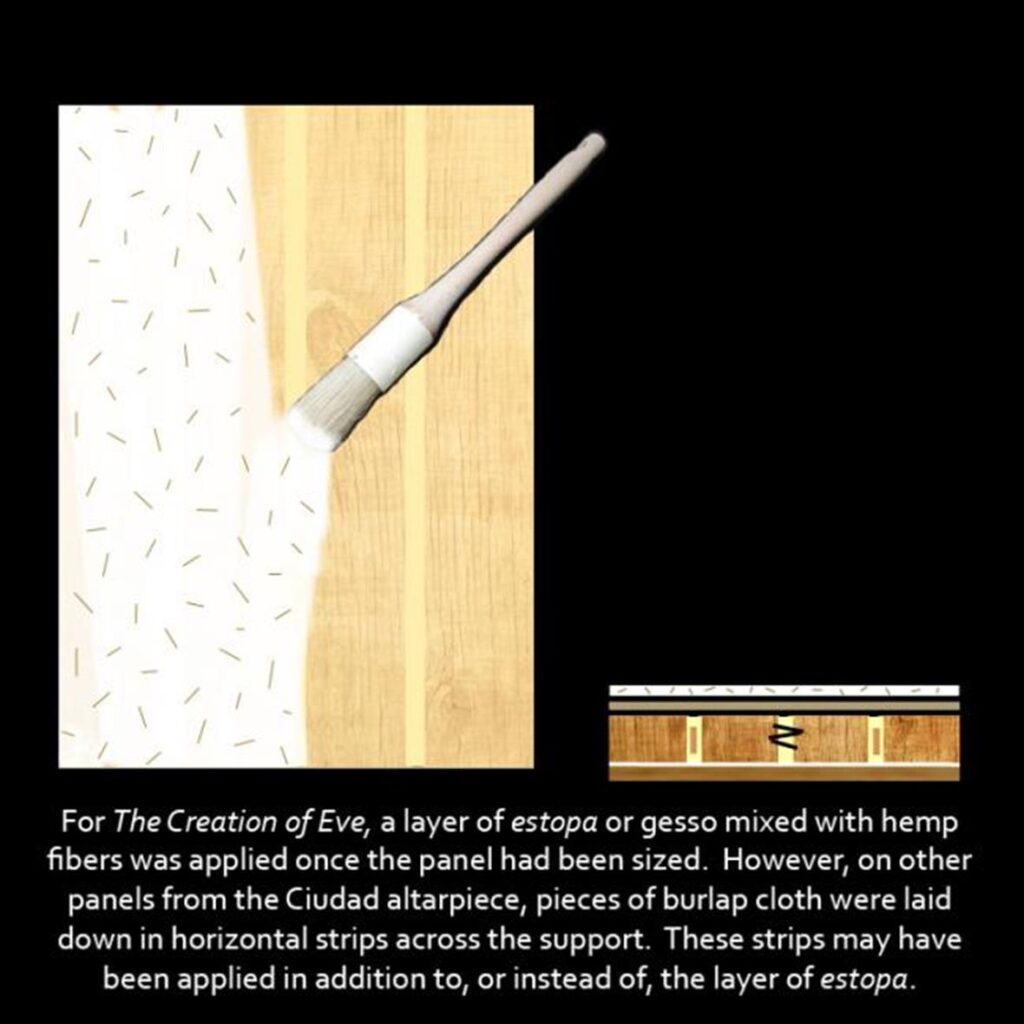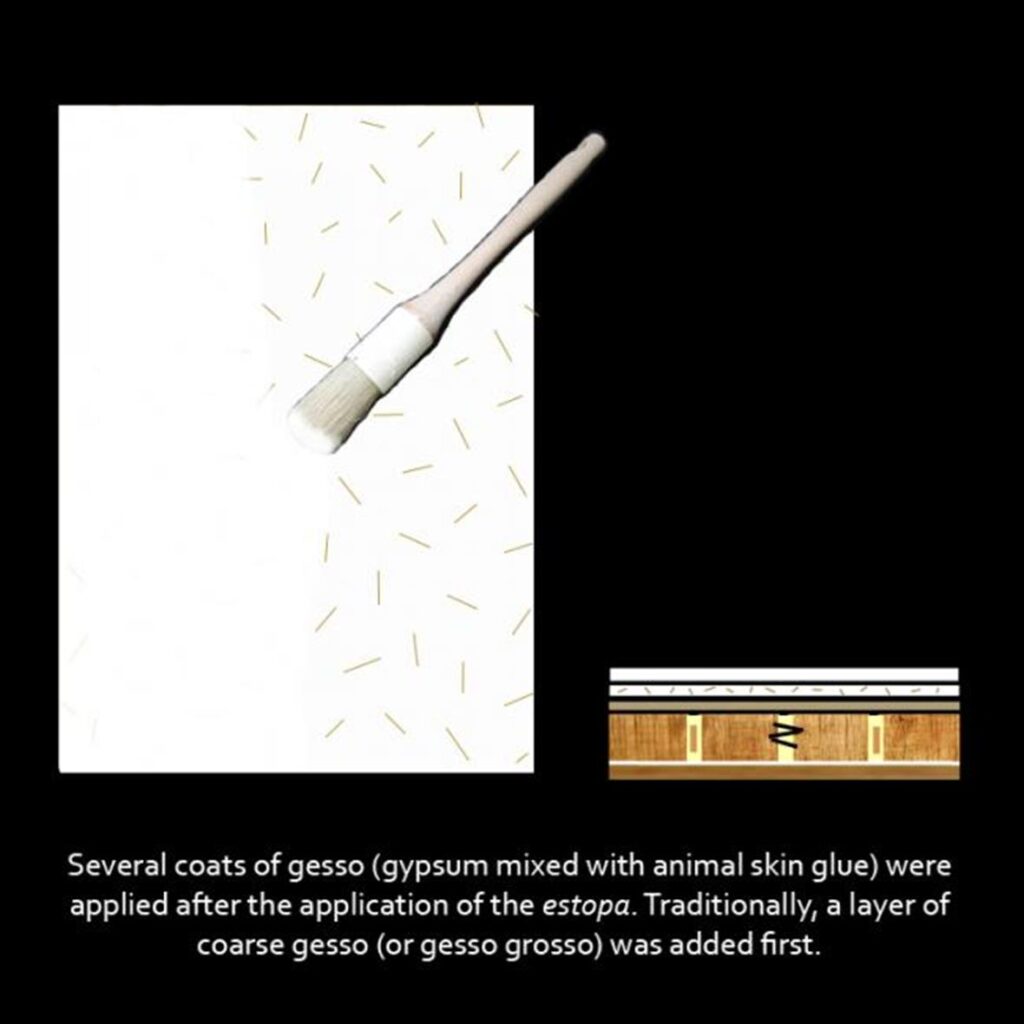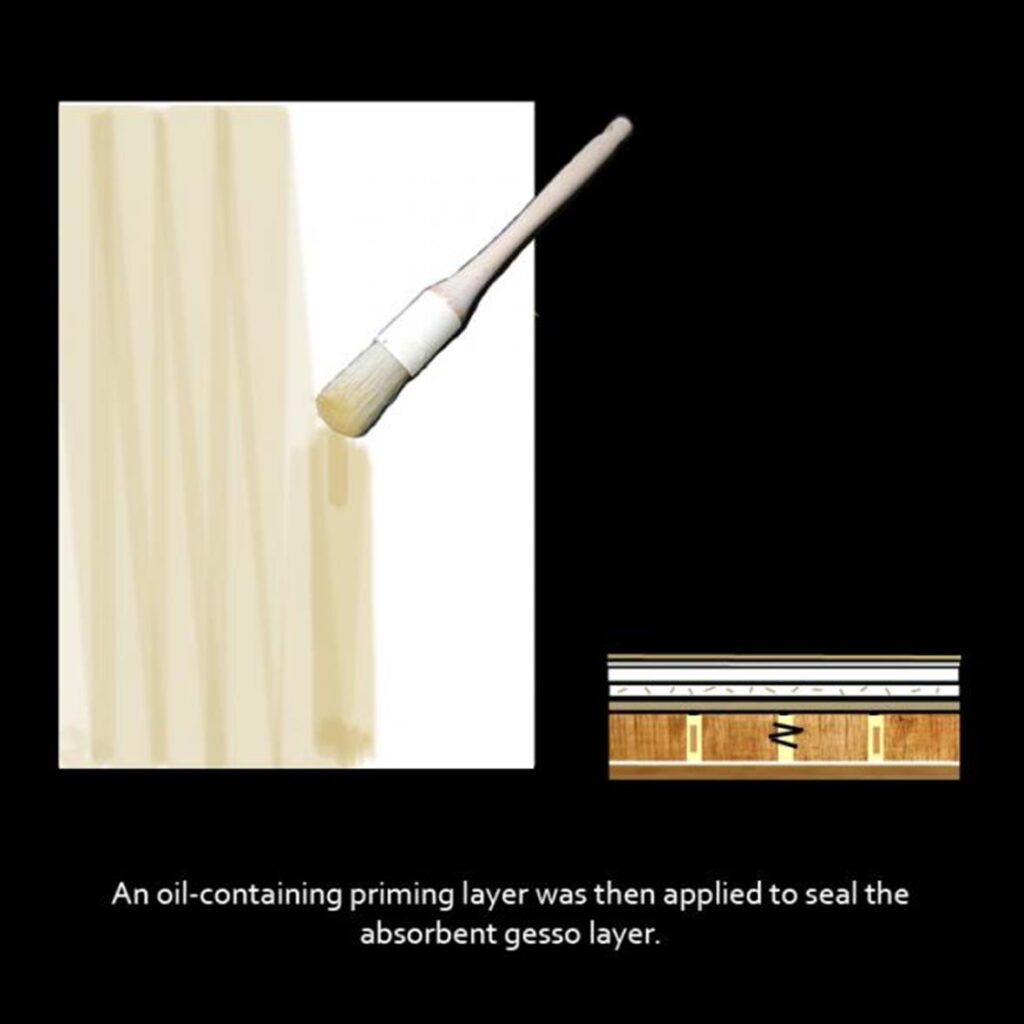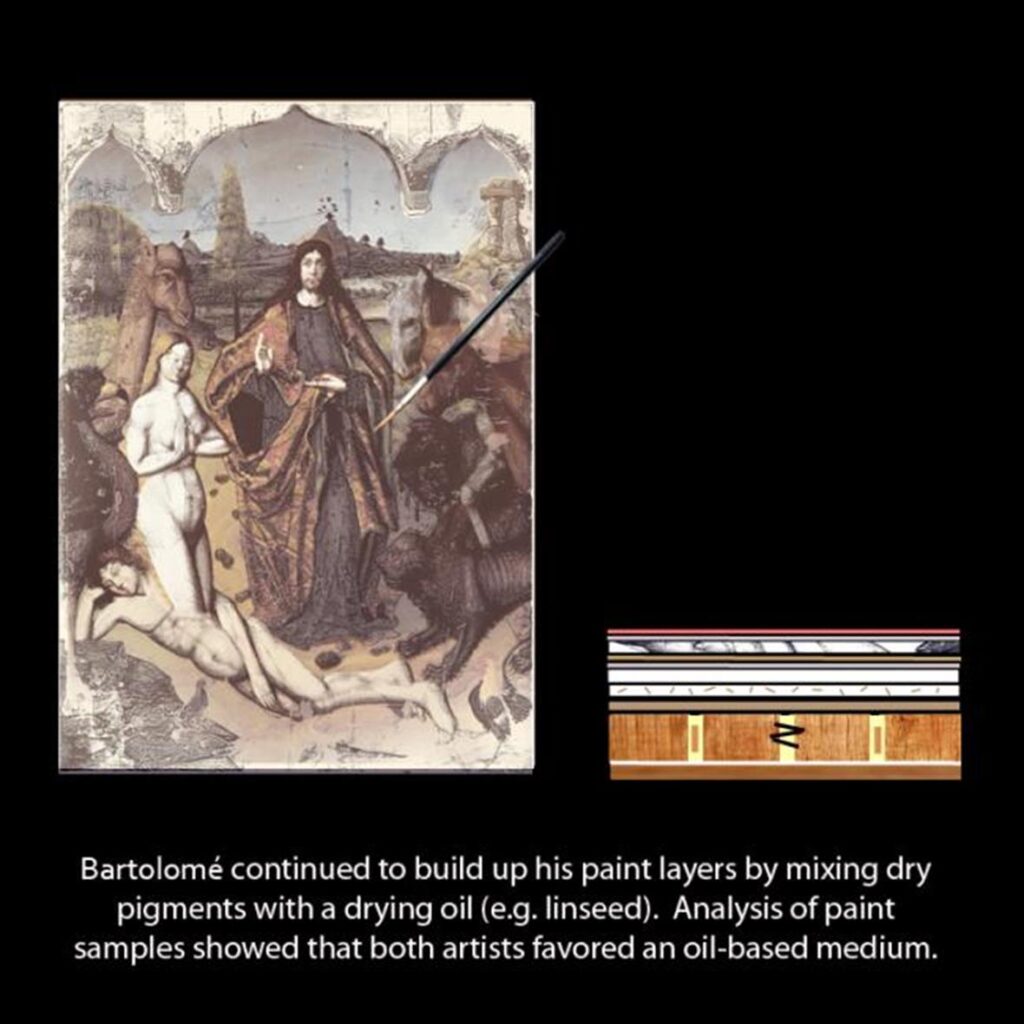The Creation of Eve (Altarpiece of Ciudad Rodrigo)
Location: The University of Arizona Art Museum
City: Tuscon, Arizona
Artist: Maestro Bartolome and his Workshop
Contents
Artist Biography
About the Painting
Related Links and Resources
References
Artist Biography
Maestro Bartolomé (second half of the fifteenth century)
Little is known about the artist referred to as Maestro Bartolomé and historical research relating to his paintings is virtually non-existent (exceptions include his panels associated with the Cathedral of Ciudad Rodrigo and those at the Church of Santa María la Mayor in Trujillo). His only signed work is a painting of the Virgin and Child (El Prado) which has the inscription “Bartolomeus.” Attributions are therefore based mainly on stylistic and technical analysis. Until recently, this artist was considered only an assistant of Fernando Gallego. However, the technical study of The Altarpiece of Ciudad Rodrigo has proved that Maestro Bartolomé was actually a master painter who led his own workshop. This suggests that the relationship between Gallego and Bartolomé was not that of master and pupil but as mutually respected collaborators.
One of the most interesting aspects of Maestro Bartolomé’s work is his occasional reference to images found in Flemish works, notably northern prints that were circulating in Spain at the time. Bartolomé quoted prints in an extremely creative manner, adapting their compositions according to a specific meaning he wanted to convey. His incorporation of such motifs reveal a personal understanding of contemporary religious and philosophical ideas. Moreover, his style is defined by an inclination for depicting distinctive facial types, a characteristic that eventually earned him the nickname “Master of the Sinister Faces” (Maestro de las Caras Sinistras).
The technique he used in the Ciudad Rodrigo panels is close to that of Fernando Gallego, although Maestro Bartolomé was more prone to using patterns and cartoons. This style is especially evident in many of his figures. Bartolomé’s underdrawings are found to be less fluid and executed with more rigidity when compared with the extensive and graceful underdrawings associated with Gallego. However, the artist appears to have overcome this contained style during the painting process, using his oil paints to render the rich surfaces of costumes, jewels and architecture. His use of lead-tin yellow to depict exquisite golden brocades creates a naturalistic effect that is only partially achieved by Gallego who opted instead to use estofado technique.
About the Painting
The Creation of Eve is one of the twenty-six panels that remain from The Altarpiece of Ciudad Rodrigo executed by Fernando Gallego, Maestro Bartolomé and their respective workshops. The altarpiece was completed between 1480 and 1488 for the cathedral of Ciudad Rodrigo, Spain, and was dismantled in the sixteenth century. However, changes of composition unveiled through technical analysis demonstrate that this specific panel was added or modified after the publication of The Nuremberg Chronicles in 1493.
This representation of the Creation of Eve is standard for the fifteenth century. The artist in this case was inspired by prints attributed to Martin Schongauer and images associated with the Nuremberg Chronicle. Bartolomé quotes several elements from the latter including the griffin and the figures of Adam and Eve. Technical analysis using infrared reflectography (IRR) shows that originally the figure of Eve was located behind the figure of Adam. However, it seems that after the publication of the Nuremberg Chronicle Maestro Bartolomé decided to change the composition of the painting in order to create a more dramatic scene. The camel and griffin were subsequently added and the figure of Eve was altered to show her springing forth from the rib cage of Adam.
Related Links and Resources
Webpage hosted by the University of Arizona Museum of Art showcasing infrared reflectograms of the entire retablo.
Secrets of the Divine. The Altarpiece of Ciudad Rodrigo
54 minute documentary about the Altarpiece of Ciudad Rodrigo including its history and the discoveries made during its technical study.
Sample of the research that unlocks 500 years of secrets
A website associated with the Southern Methodist University that compares four paintings of the Altarpiece of Ciudad Rodrigo with their respective underdrawings. This project was done in conjunction with the exhibition of the panels at the Meadows Museum.
History of panel-making techniques
Publication by the Getty Institute that includes the following chapters about panel-making: “Historical Overview of Panel-Making in Central Italy” by Luca Uzielli, “Wooden Panels and Their Preparation for Painting from the Middle Ages to the Seventeenth Century in Spain” by Zahira Véliz, “Historical Overview of Panel-Making Techniques in the Northern Countries” by Jørgen Wadum, and “The Making of Panels. History of Relevant Woodworking Tools and Techniques” by Philip Walker.
Retablo de la Iglesia de San Nicolas de Bari de Madrigal de las Altas Torres (Spanish)
This article discusses the reconstruction done by the Fundación del Patrimonio Histórico de Castilla y León of a Hispano-Flemish altarpiece located in the Church of Saint Nicholas of Bari. The style of the remaining panels suggests that this work was executed by artists belonging to the circle of Fernando Gallego and García del Barco.
El Retablo de Santa Maria la Mayor de Trujillo (Spanish)
This article discusses the underdrawings of the Altarpiece of Santa María la Mayor in Trujillo, Spain, unveiled through the use of infrared reflectography. The authors propose that only one artist was in charge of the composition and the underdrawings of the panels, while other artists were involved with the painting process. They also compare the style of the painting with that of the Triptych of the Virgin of the Rose at the Salamanca Cathedral.
La Pintura Europea sobre Tabla (articles in Spanish, French, Italian and English)
Book that compiles several articles related to the study of panel painting in Europe between the fifteenth and the seventeenth centuries.
References
Anderson, Barbara C. “Maestro Bartolomé: The Artist in an Era of Humanism and Apocalypse.” In Fernando Gallego and His Workshop. The Altarpiece from Ciudad Rodrigo, edited by Amanda W. Dotseth, Barbara C. Anderson and Mark A. Roglán, 73-115. Dallas: Meadows Museum, SMU and Philip Wilson Publishers, 2008.
Antelo, Tomás, Araceli Gabaldón and Carmen Vega. “El Retablo de Santa María la Mayor de Trujillo: dibujo subyacente.” In Revista del Instituto del Patrimonio Histórico Español, 8 (2008): 75-88.
Barry, Claire. “The Making of the Ciudad Rodrigo Altarpiece.” In Fernando Gallego and His Workshop. The Altarpiece from Ciudad Rodrigo, edited by Amanda W. Dotseth, Barbara C. Anderson and Mark A. Roglán, 147- 243. Dallas: Meadows Museum, SMU and Philip Wilson Publishers, 2008.
Dotseth, Amanda. “Maestro Bartolomé’s Use of Prints in the Altarpiece of Ciudad Rodrigo.” In Fernando Gallego and His Workshop. The Altarpiece from Ciudad Rodrigo, edited by Amanda W. Dotseth, Barbara C. Anderson and Mark A. Roglán, 117-145. Dallas: Meadows Museum, SMU and Philip Wilson Publishers, 2008.
Gabaldón, Araceli, Tomás Antelo and Carmen Vega. “Estudio radiográfico del soporte de obras de dos autores castellanos del siglo XV: Pedro Berruguete y Fernando Gallego.” In La Pintura Europea Sobre Tabla Siglos XV, XVI y XVII, 134-38. Madrid (?): Ministerio de Cultura, 2010
Garrido, Carmen. “Las técnicas flamencas e italianas en relación con la pintura española de los siglos XV y XVI.” In La Pintura Europea Sobre Tabla Siglos XV, XVI y XVII, 126-33. Madrid (?): Ministerio de Cultura, 2010.
Gómez, Marisa. “Estudio analítico de la técnica pictórica. Aplicación a tablas y retablos españoles” in La Pintura Europea Sobre Tabla Siglos XV, XVI y XVII, 148-59. Madrid (?): Ministerio de Cultura, 2010.
Sanz Fernández. Francisco, Fernando Gallego y su Taller en el Altar Mayor de Santa María la Mayor de Trujillo (Cáceres). Trujillo?: Palacio de Barrantes Cervantes S.L., 2009.
Silva Maroto, Pilar. “El Antiguo Retablo Mayor de la Catedral de Zamora. Fernando Gallego, su Taller y sus Colaboradores.” In Sumas y Restas de las Tablas de Arcenillas. Fernando Gallego y el Antiguo Retablo de la Catedral de Zamora, edited by Rosario García Rozas, 15-47. Valladolid: Junta de Castilla y Leon, 2007.




